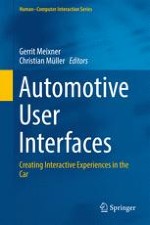2017 | OriginalPaper | Chapter
12. Towards Adaptive Ambient In-Vehicle Displays and Interactions: Insights and Design Guidelines from the 2015 AutomotiveUI Dedicated Workshop
Authors : Andreas Löcken, Shadan Sadeghian Borojeni, Heiko Müller, Thomas M. Gable, Stefano Triberti, Cyriel Diels, Christiane Glatz, Ignacio Alvarez, Lewis Chuang, Susanne Boll
Published in: Automotive User Interfaces
Publisher: Springer International Publishing
Activate our intelligent search to find suitable subject content or patents.
Select sections of text to find matching patents with Artificial Intelligence. powered by
Select sections of text to find additional relevant content using AI-assisted search. powered by
